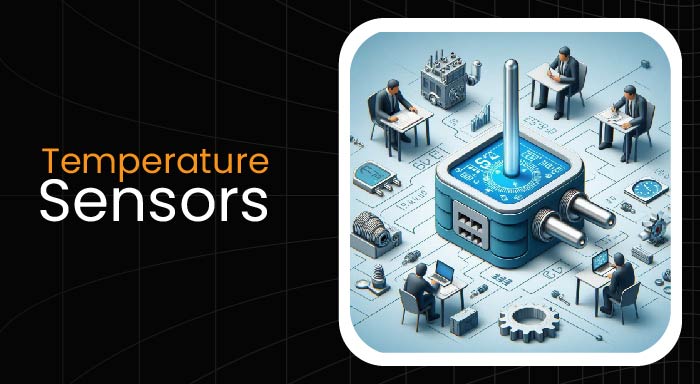Temperature sensors play an important role in many applications across industries such as healthcare and manufacturing. They assist in temperature regulation and protection of performance such that the overall function of devices is maintained.
This article expands more on the discussion of the various classes of temperature sensors and the use that is associated with them coupled with their advantages.
Types of Temperature Sensors
Thermocouples
Thermocouples are probably the most common temperature devices in existence in the market. The essentials of these instruments are formed of two dissimilar metals connected at one end, and this forms a point of contact where the temperature is monitored.
The voltage generated at this junction is directly ratio to the temperature difference between the two ends of the wire. This is true because it can measure varying temperatures as well as industrial temperatures and has a long lifespan.
Resistance Temperature Detectors (RTDs)
RTDs work based on changes in the resistances of metallic substances with the temperature change. These are made up of platinum, pure nickel, or copper. RTDs possess high accuracy and stability and that makes them useful when precision is noteworthy such as in laboratory and industrial processes.
Thermistors
Thermistors comprise of compounds that alter their resistance value based on the levels of the surrounding temperature. They come in two types: There are two popular types namely Negative Temperature Coefficient (NTC) and Positive Temperature Coefficient (PTC).
NTC thermistors, when the temperature is raised, its resistance is reduced and on the other hand PTC thermistors when the temperature is raised its resistance is increased. As they are sensitive and respond quickly, they are widely employed in home appliances and automobiles.
Infrared Sensors
Infrared temperature IoT sensors measure the intensity of thermal radiation emitted from the surface of an object. They are non-contact type sensors and are very useful where direct contact with the objects or environment being measured is dangerous or when measuring the temperature of moving objects. Far infrared sensors are applied in medical thermometers and industrial monitoring systems and heating, ventilation, and air conditioning.
Self-reading temperature sensors
Based on semiconductor material, measure temperature by employing some physical characteristics of the semiconductor. They are small in size, economical, and offer a straight-through throughput. These sensors are normally used in consumer electronics, automobile and air conditioning systems, and environment monitor devices.
Applications of Temperature Sensors
Industrial Automation
Temperature sensors are very essential in monitoring processes in industries and thus the importance of industrial automation. They make certain that the temperatures of machinery do not go high, which may cause a malfunction of the machines.
Healthcare
In the healthcare sector, temperature sensors are used in various medical devices, such as digital thermometers, incubators, and MRI machines. Accurate temperature measurement is vital for patient care and the proper functioning of medical equipment.
Automotive
Temperature sensors in vehicles monitor engine temperature, exhaust gases, and cabin climate control. They help optimize engine performance, reduce emissions, and enhance passenger comfort.
HVAC Systems
Heating, Ventilation, and Air Conditioning (HVAC) systems rely on temperature sensors to maintain desired indoor temperatures. These sensors ensure energy efficiency and comfort by regulating heating and cooling systems.
Consumer Electronics
Temperature sensors are integral to the functioning of smartphones, laptops, and other electronic devices. They prevent overheating by regulating the device’s temperature, ensuring longevity and performance.
Benefits of Temperature Sensors
Precision and Accurateness
Modern used temperature sensors have higher accuracy and precision thus making the temperature measurements accurate. This is particularly important in cases where small changes in temperatures can affect functionality or risks posed to the surrounding assets.
Energy Temperature
Sensors also ensure that the use of energy is controlled and checked to ensure maximum efficiency. This is especially so with our HVAC systems and other processes in industries where efficiency is equal to saving costs.
Safety
Overheating and risk factors are eliminated by Safety Temperature Sensors thus promoting safety. In industrial applications, they allow access to information that will prevent equipment breakdowns and accidents hence maintaining safety.
Versatility
Flexibility Due to the availability of different categories of temperature sensors, they can be applicable in so many areas. As such, temperature sensors can be used in almost every industry, including health care and automotive industry.
Cost-Effectiveness
Ease of Use Temperature sensors are easy to use since they offer numerous advantages with little or no costs associated with implementation. It is an age-old fact that they are capable of enhancing productivity and safety measures with eventual cost reduction.
Conclusion
Temperature sensors are indispensable tools in modern technology, providing accurate and reliable temperature measurements across various industries. Their versatility, precision, and cost-effectiveness make them essential for ensuring safety, efficiency, and optimal performance.
Temperature Sensors - FAQs
- What is the difference between a thermocouple and an RTD?
Thermocouples generate a voltage based on the temperature difference between two metals, while RTDs measure temperature by correlating the resistance of a metal with temperature. RTDs are generally more accurate but have a narrower temperature range compared to thermocouples.
- How do infrared temperature sensors work?
Infrared temperature sensors detect thermal radiation emitted by an object. They measure the intensity of this radiation and convert it into a temperature reading, allowing for non-contact temperature measurement.
- What are the common applications of thermistors?
Thermistors are commonly used in household appliances, automotive temperature control, and electronic devices. Their sensitivity and rapid response make them ideal for applications requiring precise temperature monitoring.
- Why are temperature sensors important in industrial automation?
Temperature sensors ensure that industrial processes operate within safe temperature limits, preventing equipment damage and ensuring product quality. They are essential for maintaining efficiency and safety in automated systems.
5. Can temperature sensors be used in hazardous environments?
Yes, certain temperature sensors, such as infrared sensors, are designed for use in hazardous environments. They can measure temperature without direct contact, making them suitable for applications in extreme conditions.
Related Posts


